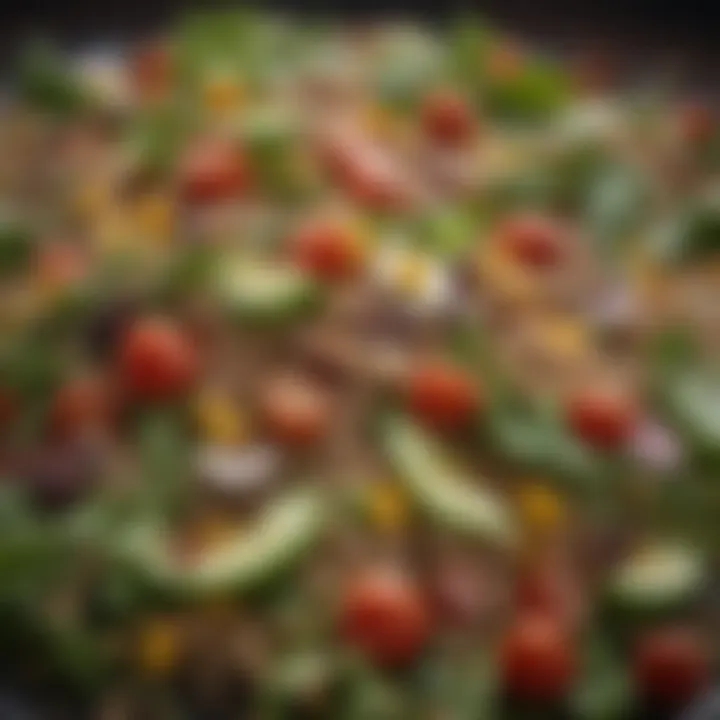Healthy Eating: Discovering Low-Salt Foods


Intro
In a world where health and wellness take center stage, the quest for low-sodium foods becomes increasingly relevant. The significance of managing sodium intake isn't just a fad; it's a practical approach that can lead to better health outcomes. Understanding what foods are low in salt, their health benefits, and alternative ways to enhance flavor can transform the way we eat. In this guide, we’ll explore the ins and outs of incorporating little to no salt into meals while still keeping them enjoyable and satisfying.
With the impending rise of heart disease, hypertension, and other sodium-related health issues, the onus is on us to make wiser dietary choices. The very idea of forgoing salt may sound daunting. Yet, the truth is that many delicious and vibrant options can take its place. The focus will not just lie on the “why” of choosing low-salted foods, but also on the “how” — from cooking techniques to selecting the right ingredients.
Notably, diving into this realm can yield more than just physical benefits. By making mindful choices in the kitchen, one can also nurture better mental health. The act of cooking can be therapeutic, promoting mindfulness and a connection to what we consume. Preparing low-sodium meals means one is also engaging with fresh produce and whole foods, which directly correlate with a well-balanced diet.
Through various sections of this piece, we’ll unfold aspects related to wellness, nutritional strategies, and practical solutions that help to cut back on sodium without sacrificing taste. Get ready to uncover flavorful alternatives, innovative cooking practices, and a wealth of information that aligns with dietary concerns and lifestyle aspirations. Let's embark on this culinary journey together.
Understanding Sodium: The Basics
Understanding sodium is key in navigating the landscape of health-conscious eating. Sodium is not just a compound in table salt; it’s a mineral that plays several critical roles in our body. In the context of this article, grasping the fundamental concepts of sodium can lead the way to making healthier dietary choices that prioritize both health and flavor.
What is Sodium?
Sodium is a chemical element that belongs to the alkali metal group. On its own, you might encounter it in various salts, principally sodium chloride. However, it’s essential for bodily functions. It helps in regulating blood pressure, maintaining fluid balance, and enabling muscle contractions. While we need sodium for survival, the average person tends to consume more than they actually require. This excess can lead to health complications.
Daily Sodium Recommendations
When it comes to daily sodium intake, guidelines set by health organizations often suggest keeping it below 2,300 milligrams for the general adult population. However, some individuals—like those with hypertension or certain heart conditions—may benefit from even lower limits, around 1,500 milligrams a day. Here’s a simple breakdown to consider:
- General population: Aim for less than 2,300 mg per day.
- Individuals with high blood pressure: Ideally under 1,500 mg daily.
- Special populations (like athletes): Needs can vary and may require higher sodium during intense physical activity.
However, don’t just think of it as a hard and fast number; it’s crucial to tailor sodium intake based on personal health concerns.
Health Implications of High Sodium Intake
While sodium is vital, too much of it can be a slippery slope towards health issues. Excess sodium is often linked to high blood pressure, which can serve as a precursor to more severe conditions such as heart disease and stroke. It can also lead to kidney dysfunction, as the kidneys struggle to filter out the increased amounts.
"Too much sodium can turn the body's natural processes upside down, leading to long-term complications that are better avoided through mindful eating."
In recent years, studies have showcased a clear connection between high sodium diets and chronic illnesses. Reducing sodium isn't just about cutting back on salt, but also involves being aware of hidden sources—processed foods and restaurant meals often have high sodium levels that can catch you unawares.
The Role of Dietary Salt
Salt, primarily composed of sodium chloride, plays a multifaceted role in our diets. Understanding its purpose is crucial, especially when attempting to limit sodium intake. While many recognize salt as a flavor enhancer, its effects extend beyond just taste. In this section, we will dissect the functional properties of salt in food and its impact on flavor and preservation, helping to clarify why it's a staple in many recipes and food processing methods.
Functional Properties of Salt in Food
Salt serves several essential functions in culinary practices. Firstly, it acts as a preservative. For centuries, salt has been used to cure meats and vegetables, drawing moisture out of food and creating an environment unfavorable for bacteria growth. Examples abound in traditional practices — think of smoked salmon or pickled vegetables. This ability to prolong shelf life means that salt is a key player in food safety.
Additionally, salt enhances texture. It has the unique ability to alter the structure of proteins, making them more tender when added in the right quantity. This is particularly noticeable in the preparation of meat, where marinating with salt can yield a juicy, flavorful result. This is not just limited to proteins; even dough benefits from a sprinkle of salt, helping to strengthen gluten and improve elasticity.
Finally, salt is instrumental in controlling fermentation processes. When fermenting foods like sauerkraut or yogurt, the right amount of salt ensures that beneficial bacteria thrive while harmful bacteria are kept at bay.
Salt's Impact on Flavor and Preservation
When we discuss flavor, the role of salt cannot be overstated. Salt enhances sweetness and masks bitterness, creating a well-rounded taste profile. Many chefs will tell you that a pinch of salt can elevate a dish from bland to exceptional. This magic happens because salt interacts with our taste buds, stimulating sensations that highlight the intrinsic flavors of ingredients.
Salt's impact on preservation also ties into flavor. Foods that are salted typically develop complex flavors over time, a process enhanced through fermentation or aging. For instance, think about aged cheeses or cured meats, which boast deep, umami flavors due to their time interacting with salt.
However, it's essential to be mindful of how much salt we use. The delicate balance of using enough to enhance taste while reducing the risks associated with high sodium consumption is key. By understanding the role of salt in these contexts, we can make informed decisions about how to incorporate flavors without overdoing it.
"Moderation is key, and understanding how salt works can lead to healthier and tastier meals!"
Ultimately, recognizing these functions offers insights into why minimizing salt isn’t just about cutting back, but rather about re-thinking the culinary landscape. By leveraging different techniques and ingredients, it's possible to preserve flavor while embracing a lower-sodium lifestyle.
Identifying Low and Salt-Free Foods
In the realm of dietary choices, pinpointing foods with minimal or no salt is crucial for those looking to improve their overall health. Salt, while a common cooking staple, can lead to a host of health issues when consumed in excess. By opting for low-sodium options, individuals can mitigate risks related to hypertension, heart disease, and other cardiovascular complications. Moreover, recognizing these foods allows for a more balanced nutrient intake that emphasizes natural flavors, promoting a deeper appreciation of culinary experiences.
Fruits and Vegetables
Fruits and vegetables are the champions of any low-sodium diet. Naturally rich in vital nutrients and lacking in sodium, they serve as a great foundation for meals. Whether it’s crisp apples, juicy oranges, vibrant spinach, or earthy carrots, these foods not only deliver on taste but also on health benefits. The dietary fiber found in these plants aids in digestion, while antioxidants bolster overall immunity.


Additionally, incorporating a variety of colors in your fruit and veggie choices ensures a wide range of vitamins and minerals. For example, red bell peppers provide vitamin C, while dark leafy greens offer a hefty dose of iron. When you reach for the produce aisle, you’re not just cutting back on salt; you’re investing in your long-term wellness.
Whole Grains
Whole grains like quinoa, brown rice, and barley are often overlooked in the sodium conversation. Unlike processed grains, which can pack a punch of salt for flavor or preservation, these options are naturally low in sodium. They act as excellent sources of energy and are loaded with fiber, which is integral for a healthy digestive system. Moreover, whole grains can absorb flavors from herbs and spices, enhancing your meals without needing to add salt.
For instance, a quinoa salad tossed with lemon juice, fresh herbs, and chopped vegetables can provide a refreshing, zesty flavor while keeping sodium levels in check. Opting for whole grains not only diversifies your plate but supports sustained energy and satiety throughout the day.
Lean Proteins
When thinking about lean proteins, it's essential to look for options that allow you to maintain a low-sodium intake. Chicken breast, turkey, and fish like salmon stand out as excellent choices. Not only are these proteins lower in fat, but they also fit the bill for being salt-conscious. Preparing them with techniques like grilling or baking, instead of frying or marinating with high-sodium sauces, can further enhance their health benefits.
When cooking these proteins, consider using flavored rubs made from garlic, paprika, or cayenne pepper to boost taste. These alternatives ensure you’re enjoying a hearty meal without the addition of salt. Plus, lean proteins play a critical role in muscle repair and growth, making them a staple in a balanced diet.
Legumes and Nuts
Legumes such as lentils, chickpeas, and beans are a treasure trove for those seeking low-sodium protein sources. Not only are they low in sodium, but they are also high in fiber and protein, making them incredibly filling. Nuts, while a bit higher in calories, provide healthy fats and can be a delightful snack option. Remember to choose unsalted varieties for that additional control over sodium intake.
Incorporating legumes into recipes can elevate a simple dish—think of a creamy bean dip or a hearty lentil soup. These not only enrich your diet but pave the way for culinary creativity. By focusing on these foods, you're not just chasing a low-sodium lifestyle; you're embracing a diverse and nutritious way of eating that can yield significant health benefits.
"Choosing low-sodium foods is not just about restriction, it's about discovering a broader horizon of flavors and health benefits."
By understanding and identifying these categories—fruits, vegetables, whole grains, lean proteins, legumes, and nuts—you empower yourself to make informed decisions aligned with your health goals. This step invites you to rethink your culinary approaches, prioritize your well-being, and explore a world where taste doesn’t have to take a backseat to health.
Cooking Methods That Preserve Flavor
In the world of low-sodium cooking, the methods used can make a huge difference in taste and experience. Proper cooking techniques not only bring out the natural flavors of ingredients but also allow individuals to enjoy vibrant meals without relying on copious amounts of salt. Understanding these cooking methods can empower you to create dishes that are not only healthy but also satisfying and delicious.
Herbs and Spices as Seasoning Alternatives
When you swap out salt, you want to still enjoy food that packs a punch. This is where herbs and spices step into the limelight. Fresh basil, oregano, or thyme, for instance, can elevate a simple meal to a new level without the need for added sodium. Spices like cumin or smoked paprika can lend a depth of flavor that often makes people forget about salt entirely.
Using herbs and spices is not just about throwing something extra into the pot. It’s also about balancing flavors. For example, when preparing a vegetable stir-fry, a sprinkle of red pepper flakes can create a delightful kick, while a dash of rosemary on baked potatoes puts a fresh twist on the classic favorite. Experimenting with these options allows for creativity and helps foster a greater appreciation for the ingredients themselves.
Utilizing Acidity in Cooking
Acidity can do wonders in cooking, especially when you're aiming for flavor without the salt. Ingredients like vinegar, lemon juice, or even tomatoes can add brightness and complexity to dishes. The tanginess from these elements can enhance overall flavor profiles, making food more appealing and satisfying.
For instance, a squeeze of fresh lime over a quinoa salad can brighten all the other flavors present. Similarly, a balsamic vinegar glaze can transform roasted vegetables into a gourmet side dish. Utilizing acid helps to awaken the palate and can create layers of flavor that often compensate for the lack of traditional seasoning.
Creative Cooking Techniques
Roasting
Roasting takes advantage of dry heat, often resulting in beautifully caramelized foods. This technique is welcome news for anyone looking to cut back on salt. When you roast vegetables, naturally occurring sugars come out, creating a rich flavor through browning. Not only does roasting enhance the overall taste, but it also preserves nutrients better than some high-heat cooking methods.
One unique feature of roasting is that it can intensify individual flavors, making each bite diverse and flavorful. The main disadvantage is that it usually takes a bit longer than some other methods, which can require patience.
Grilling
Grilling brings its own unique charm to low-salt cooking by creating a wonderful smoky flavor. This method is particularly good for lean meats and vegetables, allowing them to cook quickly over high heat. The key characteristic of grilling is its ability to keep the food juicy and tender by searing the outside, which locks in flavors and moisture.
However, balancing heat levels is essential. If you're not careful, you might end up with charred food rather than a beautifully grilled meal. But when done right, the grill can add a new dimension of taste that makes you forget salt was even a consideration.
Steaming
Steaming serves as one of the healthiest cooking methods out there. It preserves vitamins and minerals while ensuring that food retains its fresh qualities. Steamed vegetables keep their crunch and color, making them visually appealing as well.
One of the standout features of steaming is how it maintains the natural flavors of ingredients. This can be a significant advantage, especially for those who appreciate the inherent tastes of their food without much alteration. However, it can sometimes be perceived as less flavorful than roasted or grilled options. This is where adding a few herbs or a drizzle of lemon juice can truly make a difference.
Utilizing various cooking methods can greatly enhance your culinary experience while adhering to a low-sodium lifestyle. By embracing flavor through alternative means, you ensure that your meals are both nourishing and enjoyable.
In summary, elevating food without incorporating salt relies heavily on how you prepare it. Each cooking method has its own strengths and can highlight natural flavors that salt often overshadows. As you experiment with these techniques, you'll develop a deeper appreciation for the simple ingredients that make up your meals.
Recipes Featuring Little to No Salt
When it comes to curbing sodium intake without sacrificing flavour, exploring recipes that contain little to no salt becomes essential. This section delves into a variety of dishes and snacks that not only promote health but also cater to the palate. Ultimately, the goal is to create meals that are enjoyable and nourishing, demonstrating that a low-sodium lifestyle need not be bland or boring.


Savory Dishes
Vegetable Stir-Fry
A vegetable stir-fry is a vibrant choice that showcases seasonal produce while keeping sodium levels low. The key characteristic of this dish lies in its versatility; you can toss in whatever vegetables you have on hand. Bell peppers, broccoli, and carrots work wonderfully together, providing a medley of colours and textures. The unique feature of a vegetable stir-fry is its ability to absorb flavours from fresh herbs and spices rather than relying on salt. It’s an easy, quick meal option that brings out the natural sweetness of vegetables, making it a popular choice in this article for busy families seeking healthy, flavourful options.
Quinoa Salad
Quinoa salad stands out as a nutritious staple, rich in protein and fibre. This dish offers the advantage of being both filling and light, which is ideal for those aiming for a healthy diet. The texture of quinoa coupled with crunchy cucumbers and juicy tomatoes creates an engaging bite. One unique feature of quinoa salads is their adaptability; you can easily throw in beans or nuts for added texture and nutrition. Not only is it a beneficial choice for a low-sodium diet, but it also nourishes the body, keeps your energy up, and is visually appealing.
Herb-Crusted Chicken
Crafting herb-crusted chicken provides a flavoursome experience without added sodium. The characteristic of this dish is its aromatic crust made from fresh herbs like rosemary, thyme, and parsley. This herb combination elevates the chicken, making it juicy and packed with taste. A standout aspect is that it promotes healthier cooking methods like baking or grilling, which also helps retain nutrients. While it's a crowd-pleaser during family dinners, one potential disadvantage could be the need to experiment with different herbs to find the perfect balance that pleases everyone's palate.
Snack Options
Roasted Chickpeas
Roasted chickpeas serve as a crunchy, satisfying snack option that can easily replace chips. Their distinct character lies in their high protein content, making them a filling choice that helps stave off hunger. When using spices like paprika or garlic powder, you can create a rich flavour profile without needing salt. This snack is not only wholesome but can also be customized based on individual taste preferences, being both beneficial and delightful.
Fruit Smoothies
Fruit smoothies offer a refreshing alternative, especially for those looking to incorporate more fruits into their diet. The beauty of these smoothies is the ability to blend various fruits like bananas, berries, and spinach, creating a veritable rainbow of health benefits. This drink is particularly advantageous during the warmer months, providing hydration alongside nutrients. A unique feature is the natural sweetness from the fruits, eliminating the need for sugar or any extra additives. On the flip side, smoothies may lack nutritional heft if not balanced properly, so adding a spoonful of nut butter or chia seeds can enhance their nutritional profile.
Vegetable Chips
Making vegetable chips can be a creative way to satisfy cravings without resorting to high-sodium options. They pack the benefit of providing the crunch you'd miss from conventional chips while offering the vitamins and minerals inherent in vegetables. Baking them allows for enhanced flavour when sprinkled with seasoning blend that doesn't rely on salt. The unique aspect here is the potential for variety—kale, zucchini, or sweet potatoes can be transformed into healthy chips. While they can be delicious, one disadvantage is that they may require some trial and error in the cooking process to avoid undercooking or burning, but the end results are worth it.
Sweet Treats
Banana Oatmeal Cookies
Banana oatmeal cookies present a sweet yet healthy option. The mix of oats and ripe bananas creates a naturally sweet and satisfying treat that's easy to prepare. The main characteristic is their chewy texture, which is great for those with a sweet tooth who still want to maintain a balanced diet. They offer the unique feature of being adaptable—they can include add-ins like nuts or chocolate chips without overwhelming the low-sodium goal. A potential downside is that they might not satisfy all cravings for traditional cookies, which could deter some from trying them.
Chia Seed Pudding
Chia seed pudding has gained popularity as a nutritious, low-sodium dessert. Its key characteristic is the unique texture, which becomes gel-like when mixed with milk or a milk alternative. The pudding can be flavoured with vanilla or fruit puree, offering a naturally sweet indulgence. It’s rich in omega-3 fatty acids, which is a significant nutritional benefit. A unique feature is the ease of preparation—it can be made ahead and kept in the fridge for easy breakfasts or snacks. However, some might find the gelatinous texture unappealing at first, which could be a barrier for trying it out.
You Can Make Your Own Yogurt
Making your own yogurt is not only cost-effective but also a valuable skill for a low-sodium diet. The main characteristic of homemade yogurt is that it allows you to control the ingredients, resulting in a healthier product without unnatural additives. It brings about the unique advantage of fostering gut health, as it contains live bacteria beneficial for digestion. While it may be slightly time-intensive, the upside is that it can be customized with fruits, nuts, and spices to suit personal tastes. It does require planning ahead, but the satisfaction of creating your own food is often worth the effort.
"Healthy eating doesn't have to be dull. Each recipe resonates with the simplicity and freshness of ingredients. The more you practice, the tastier it gets!"
Label Reading for Sodium Awareness
Reading labels is like peeling back the layers of an onion; each layer reveals essential information that affects your health, particularly regarding sodium content. In the journey toward adopting a low-sodium diet, understanding nutrition labels is not just useful—it’s fundamental. With many products on supermarket shelves, recognizing sodium levels can decide whether a food fits into your dietary needs or if it’s better left on the shelf.
Understanding Nutritional Labels
When you grab a package off the shelf, the nutritional label often feels like a jumble of numbers and terms, but it doesn't have to be. The most critical part for our discussion is the sodium content per serving, usually listed near the top.
Look for these key components on labels:
- Total Sodium: This is the total amount of sodium in one serving. Pay attention to this number; keeping it below the recommended daily limit can help manage blood pressure and overall health.
- Serving Size: Always check the serving size. It’s common for people to underestimate how much they eat; labeling tricks can lead us to believe something is lower in sodium than it actually is when servings are smaller than expected.
- % Daily Value (%DV): This percentage helps you gauge how much a product contributes to a daily diet. If %DV of sodium is below 5%, it's considered low; above 20% is high.
Understanding these elements makes deciphering the label more manageable and effective for your health goals.
Identifying Hidden Sources of Sodium
Sodium is like a sneaky thief in your pantry. It can hide in the most surprising products, sometimes where you least expect it, making it critical to be vigilant.
Here are some common culprits:
- Canned Foods: Soups, vegetables, and beans often have a high sodium content as preservatives. Look for low-sodium or no-salt-added versions.
- Condiments and Sauces: Ketchup, soy sauce, and salad dressings can pack a salty punch. Even those touted as 'healthier' options can add up quickly.
- Processed Snacks: Chips and crackers may seem innocent, but they're usually laden with salt. Always check the sodium level before indulging.
- Bread and Rolls: Surprised? Many breads have added sodium.
- Frozen Meals: Many convenience meals can contain hidden sodium to enhance flavor.
Keeping an eye on sodium levels, especially in your regular purchases, is crucial for maintaining a balanced, low-sodium lifestyle. Just because it’s not labeled as a ‘salty’ food doesn’t mean it won’t surprise you.


"Being aware of what's in your food is the first step to making better choices."
By honing your label-reading skills and being aware of hidden sodium, you can make informed choices that align with your goal of reducing salt in your diet. In this landscape, knowledge is not just power; it's the pathway to a healthier lifestyle.
Culinary Innovations in Low-Sodium Foods
Culinary innovation in the realm of low-sodium foods is more than just a response to the health-conscious consumer. It reflects a profound shift in how we approach cooking and food preparation, placing a premium on flavor and nutritional integrity without the reliance on traditional sodium sources. Today, as more people become aware of the health benefits associated with lower sodium intake, culinary experts are stepping up to the plate, unfurling a myriad of flavor-enhancing techniques and product options designed to entice the palate without compromising heart health.
Emerging Trends in Flavor Enhancement
Innovative cooking techniques have taken center stage as chefs and home cooks alike search for viable alternatives to help amplify flavors in a low-sodium environment. Herbs, spices, and other natural flavor enhancers are increasingly becoming the go-to options. Sourcing local and seasonal produce not only ensures freshness but also helps bolster flavors. Moreover, many are finding success with methods that add depth, such as
- Roasting vegetables to caramelize their natural sugars, accentuating their inherent sweetness.
- Fermentation, which adds an umami depth and complexity without an excess of salt. The tangy bite from fermented foods like kimchi or pickled vegetables lends a wonderful flavor profile.
- Smoky flavors achieved through smoking spices or using liquid smoke can add richness that fills the void left by salt.
These trending techniques don’t just cater to those mindful of their sodium intake; they also reveal a fascinating culinary landscape, brimming with exciting flavors that entice even the most traditional palate.
"In cooking, it’s not just about the ingredients, but also how they harmonize to create a melody of flavors without the need for salt."
Growing Popularity of Low-Sodium Products
The market for low-sodium products is growing significantly, driven by consumer demand for healthier options. Many brands are now venturing into the low-sodium range, using various processes to enhance flavor without the excessive use of salt. Here are a few noteworthy mentions:
- Low-sodium broths and stocks that maintain robust flavors, perfect for soups, stews, and sauces.
- Seasoning blends that provide a punch of flavor without the salt, allowing home chefs to explore new dishes with confidence.
- Condiments such as low-sodium soy sauce, which replicate the original’s savory impact without the health risks associated with high sodium levels.
This uptick in low-sodium offerings is not just a fad, but a result of growing awareness around dietary health. As more people embrace these options, they contribute to raising the standard for food products overall, inspiring brands to deliver quality along with health benefits.
Equipped with a better understanding of how to navigate flavors while keeping sodium levels in check, both consumers and cooks find themselves empowered. They’re exploring the vast landscape of what flavors can offer while letting go of an over-reliance on salt.
Ultimately, culinary innovations in low-sodium foods represent a promising avenue toward a healthier lifestyle, inviting everyone to savor delicious meals without compromising their health goals.
Long-Term Benefits of a Low-Sodium Diet
The idea of low-sodium eating isn’t just a fad; it’s about long-lasting change in how we view our health. Reducing sodium can significantly lower the risk of various ailments. For many, this shift is more than about flavor; it's about making a conscious choice for overall wellness. Understanding the long-term benefits associated with a low-sodium diet provides insight into why this approach is gaining traction. The advantages cut across multiple facets of life, affecting not just the heart but overall vitality.
Improving Cardiovascular Health
When we discuss heart health, sodium often finds its way into the conversation, usually in a negative light. Too much sodium can cause your blood pressure to climb, like a car speeding on an empty road without brakes. Over time, elevated blood pressure increases the risk of heart disease and strokes. Conversely, adopting a low-sodium diet can help maintain or even lower blood pressure.
For instance, it’s not just about cutting down on salt; it’s about choosing wholesome, nutritious alternatives. Foods such as leafy greens, berries, and fish, rich in potassium and omega-3 fatty acids, can further bolster cardiovascular function. The American Heart Association recommends aiming for a sodium intake of no more than 2,300 mg per day, but even lower levels like 1,500 mg can lead to better outcomes.
By focusing on a low-sodium diet, you're investing in a healthier heart not just for today, but also down the road. Regular blood pressure monitoring can be a practical step. Keeping tabs on your numbers can reveal the benefits of this dietary shift.
Enhancing Overall Well-Being
A low-sodium diet doesn't merely influence physical health; it's also a gateway to improved overall well-being. When you start eating low-sodium, one of the first things many people notice is an increase in energy. With less sodium comes less water retention, meaning your body doesn't feel sluggish. Eating low-sodium foods often pushes you toward fresh vegetables, fruits, and whole grains, all of which are powerhouses of nutrients.
Additionally, many find clarity of mind as a positive side effect. Sodium overload can lead to various health issues, like headaches and fatigue. Easing off those processed foods, which are often high in sodium, can lead to better concentration and mental function—like wiping a foggy window clean.
Another key benefit is the potential for better moods. Enjoying a diet rich in nutrients helps foster a healthy gut, crucial for mental health. With improved gut health can come reduced feelings of anxiety or depression. Ultimately, a low-sodium diet paves the way for a holistic approach to health that can help you feel better in various respects.
In summary, a long-term commitment to a low-sodium diet can yield profound improvements in both physical and mental health, making it a rewarding journey to embark upon. Whether you're a parent wanting to set a good example for your kids or just someone looking to feel their best, the low-sodium route offers numerous benefits that are well worth exploring.
Personalizing Your Salt Intake
Understanding how to personalize your salt intake is a crucial aspect of adopting a low-sodium diet. With dietary needs varying significantly from one person to another, it’s essential to take individual health considerations into account. For some, limiting salt is merely a choice for a healthier lifestyle, while others might have specific medical recommendations. Recognizing these differences plays a vital role in ensuring one's diet not only aligns with health guidelines but also accommodates personal tastes and nutritional needs.
Considering Individual Health Needs
Health needs differ based on age, medical conditions, and lifestyle choices. For instance, older adults often face heightened risks for hypertension or heart disease, making a low-sodium diet particularly beneficial. Similarly, individuals managing chronic conditions such as diabetes may need to be mindful of their sodium intake to maintain overall health.
Some key aspects to consider include:
- Existing Health Conditions: Check with healthcare professional about how sodium affects specific health issues.
- Age and Lifestyle: Younger folks may have different dietary flexibilities compared to seniors.
- Activity Level: Active individuals might require more nutrients, but they still should choose lower-sodium options without compromising taste.
With these considerations, people can adapt their recipes and food choices accordingly. For instance, someone who enjoys cooking may want to experiment with fresh herbs and spices to create flavorful dishes without needing excessive salt.
Strategies for Transitioning to a Low-Sodium Lifestyle
Shifting to a low-sodium lifestyle may seem daunting, but it doesn’t have to be. Here are some practical strategies that can ease the process:
- Start Slowly: Gradually reducing salt in daily meals can help your palate adjust. Initially, cut back by a pinch here and a dash there.
- Experiment with Alternatives: Use flavor enhancers like lemon juice, vinegar, or zest from citrus fruits to bring dishes to life. Spices such as cumin and paprika can also add depth without the sodium.
- Cook from Scratch: Prepare meals at home as much as possible. This way, you can control what goes into your food while having the freedom to explore new flavors.
- Read Labels: It’s crucial to become familiar with nutritional information on packaged foods. Look for products labeled as "low-sodium" or "no added salt."
- Stay Informed: Engage with communities on platforms like Reddit or follow health pages on Facebook to discover new recipes and tips from others who are integrating low-sodium diets into their lives.
Smart and thoughtful choices pave the path toward healthier eating habits. This personalized approach allows individuals to not only remain healthy but also enjoy the foods they love, minus the excessive salt.



